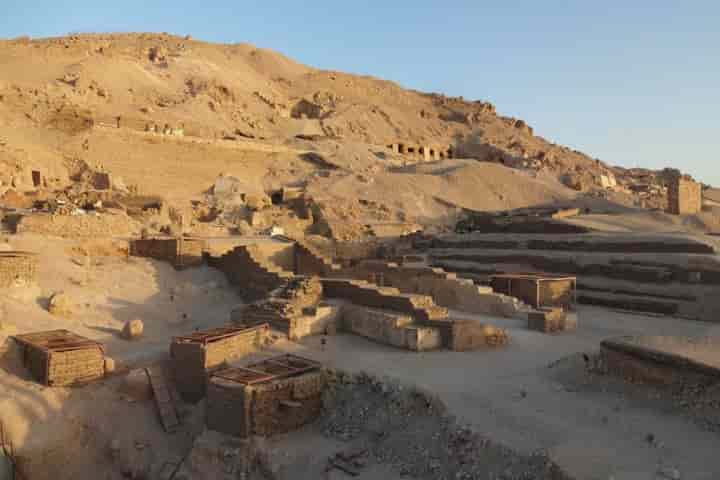Graves and remains of human beings of the past, along with their belongings throw light on the times they lived in. Apart from them, archaeologists, animals and birds entombed reveal a lot about the times and place they belonged to.
The ancient Egyptian burial area at Quesna, a city in Monufia Governorate of Egypt, which is guarded by the country’s Ministry of Tourism and Antiquities, has been a major attraction for historians and archaeologists for many years.
Also read: Will Taliban keep promise to preserve Afghanistan’s ancient historical sites?
Yet, interestingly, not all the remains that have been found here are human. It has a large number of falcons and shrews – buried 2000 years ago for certain reasons pertaining to the then prevailing religious rituals. What is noteworthy is that these creatures help us know and understand what the region’s environment and biodiversity was then.
In an article in smithsonianmag.com Neal Woodman who is a United States Geological Survey scientist and research associate at the Smithsonian’s National Museum of Natural History observed: “A lot of these animals don’t exist in Egypt anymore, so the mummies can show us how environmental change has affected animals that once lived there.”
In fact Woodman and his associates found a mummified shrew and what they found is that it belonged to a species that favours a damper climate than what prevails in Quesna at present. This group’s finding was published in the journal PLOS One and it proposes that Egypt was wetter in the past than what it is now.

(The entrance structure to the corridors of the Falcon necropolis (Pic: Courtesy popular-archaeology.com)
Tabling the logic behind this, Salima Ikram, the Museum’s Research Associate, archaeologist at the American University in Cairo and co-author on the paper said: “Because we know where this species is found in modern times and what environments it likes, we can extrapolate what environment it would have flourished in back then.”
Known as Güldenstaedt's White-toothed Shrew, this species throws light on what ancient Egypt’s environment was, and how the fauna of the place changed over a period.
Around 2500 to 2000 years ago, animal cults became popular in ancient Egypt. Thus varied animals were offered to the gods and at Falcon Necropolis, the offerings were made to god Horus. While the shrews were less prevalent, falcons were in abundance.
Also read: Excavations at Durgadevi highlight Odisha's advanced culture
Ikram said: “We don’t have the high numbers for shrews as we do for other species. It was probably easier to trap shrews rather than try and breed them. They're quite tricky to breed and very nervous.”
Assuming that people of ancient Egypt were obtaining the shrews locally, it suggests that what has been found in the Necropolis belongs to that place itself.
The mummified shrews were found in diverse conditions, from whole mummy to preserved bone fragments. Woodman told smithsonianmag.com, “We mostly work with shrew remains that were mummified but whose wrappings rotted or were destroyed. They can be easily studied because their bones are free.”
In order to decide on the species of the mummified shrew, the researchers relied on different physical attributes. These include the size, length and shape of the bone. For instance, in one mummified shrew — discovered in the Falcon Necropolis – the jawbone is slightly larger than two of its relatives at the site. “We can distinguish what species a specimen is based on its size because all shrew species at this site tend to be slightly different sizes,” remarked Woodman.
Also read: Humankind’s tryst with Coronavirus 20,000 Years Ago
The mummified Güldenstaedt's White-toothed shrew has definitely added to a better comprehension of the climate of the region over 2000 years.
Joanne Rowland, archaeologist at the University of Edinburgh, co-author on the paper and Director of the fieldwork in the Falcon Necropolis at Quesna remarked: “This all lets us find out more about the breadth of species that we’ve got, which helps us to think about the wider environment of the time and the types of creatures it could support.”
The climate fluctuations and change have been a subject matter of the scientists for quite some time and the discovery of mummified shrew and other animals at Quesna, do support the postulation that two millennia before this area was moister than what it is at present.
Elaborating on this aspect, Rowland said: “The results of our research, including sedimentary coring around the site of Quesna, also help us think about what that natural environment used to be at given points in time. We can reconstruct the proximity of the local river branch, for example, as well as considering the diversity of the animal population.”
Using the mummified animal remains, Woodman hopes to highlight the transformation of Egypt into a drier place. “What I really want is to examine a bunch of sites so we can start identifying patterns of diversity throughout the entire area,” he told the magazine.




















